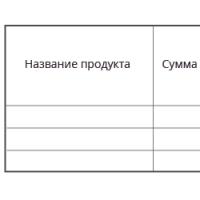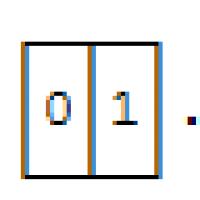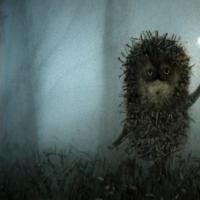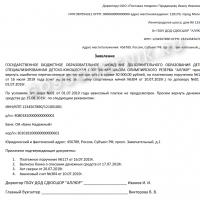Lesson summary: drawing a fairytale bird. Art activity class in the preparatory group "magic firebird". Presentation of new material
Lesson outline
in Fine Arts on the topic:
"Fairytale Bird"
Lesson plan for fine arts on the topic:
"Fairytale Bird"
Target: introduce the concept of “fantasy”, “animalism”, the image of various fairy-tale birds.
Tasks:
Educational: to develop the ability to transform real forms into decorative ones, the ability to depict on a plane.
Educational: develop imagination and the ability to select color relationships when working with paints;
Educators: cultivate cognitive interest, accuracy, diligence.
Equipment:
for the teacher: visuals depicting birds, poems about birds.
for students: album, gouache paints, brushes, water jars, pencil.
Lesson structure:
2. Report the topic of the lesson.
3. Introductory conversation.
4. Independent work of students.
5. Lesson summary.
Lesson progress:
1. Organizational moment:
Hello guys. Have a seat. Is everyone ready for today's lesson?
2. Lesson topic message:
The topic of our lesson today is “Fairytale Bird”.
3. Introductory conversation:
Today we will plunge into the world of fantasy. But before we start working, let's think about how fantasy differs from reality. What is reality?
(Children's answers)
Right. Reality is what we see, hear, feel. The artist conveys in his works what he sees around him and what interests him - people, nature, animals. Moreover, peering into nature, he strives to depict it as close to reality as possible, realistically. Therefore, we can name such an artist as?
(Realistic)
Right. Look how artists depict animals.
(The teacher shows reproductions of paintings by animal artists)
Artists E. Charushin and V. Vatagin devoted a lot of time and effort to this particular topic - “Animals and Birds.” The animals on their canvases are like real ones. What are these artists called?
(Animalists).
Today you will also play the role of animal artists. Guess the riddle:
I didn’t count the versts
I didn’t travel on the roads,
And I've been overseas.
(Bird).
And today we will depict birds. What birds do you know?
(Children's answers).
Well done. For example, Hawk (the first student reads a poem):
Hawk, hawk! Shoo, villain!
Hey, shout louder!
Come on, let the chicken out,
Evil robber, out of claws!
(Teacher hangs up a picture of a Hawk)
Hawk - big and bird of prey. It has short legs with long sharp claws, short wings and a strong hooked nose.
Which bird is considered a symbol of wisdom?
(Owl), (the second student reads a poem about the Owl):
The wisest bird in the world is the Owl.
He hears everything, but is very stingy with words.
The more he hears,
The less he talks.
Ah, this to many of us
Not enough!
(Teacher hangs up a picture of an Owl)
The Owl has a large round head and a small, seemingly flattened beak. The large eyes are located side by side on the head, and not on the sides, like in other birds.
In noisy cities and quiet villages you can meet this small, nimble bird with a brown cap and brown feathers. Who is this?
(Sparrow)
(The teacher hangs up a picture of the Sparrow, and the third student reads a poem about the Sparrow):
Sparrows - sparrows,
Little gray feathers!
Peck, peck the crumbs
From the palm of my hand!
No, they don’t peck from the palm of your hand.
And they don't let me pet you.
How can we get along?
To let them pet you?
Which bird is called the bird of peace?
(Dove)
(Teacher hangs up a picture of a Dove)
One day, the God of War Mars was getting ready for another battle. He put on his armor and reached for his helmet. But he saw that a dove had built a nest in the helmet and was already hatching its chicks. The beautiful wife of Mars, the goddess of love and beauty Venus, persuaded her husband not to touch the nest. And... the war did not take place. The Dove must have been considered the bird of peace ever since.
These were all real birds, and we will draw fabulous ones.
We are all accustomed to the real world around us; it seems to us that we know everything about it. But you and I are very curious, and if there are few mysteries and secrets around us, we can invent them ourselves. And some artists even depict fairy tale characters, animals, nature. And what helps them in this is the study of reality, which serves as an impetus for imagination.
Where is reality then, and where is fantasy? Am I reality?
(Yes).
Is class a reality?
(Yes).
Is Baba Yaga flying around our city a reality?
(No).
What is this?
(Fantasy).
Right. What birds live in fairy tales?
(Firebird, “Cockerel” by A.S. Pushkin, “The Swan Princess”, etc.)
Well done. But the basis of any fantasy is the truth of life, since the artist is able to fantasize only on the basis of what he saw and perceived in the world around him. Let's come up with your own fairytale bird today.
4. Independent work of students:
While doing the work, the teacher helps and points out mistakes.
5. Lesson summary:
The students' works are collected together and a collective analysis of the work takes place.
Which works did you like best? Why?
What new things did you learn from the lesson? What is reality? What about fantasy?
You all did a great job today, you all did great work. Well done!
This concludes our lesson, goodbye!
Applications
Reproductions of paintings by animal artists

Animal artist E. Charushin

Art lesson on the topic "Magic Birds"
Goals:
- Introduce the image of a fairy-tale bird in arts and crafts. To consolidate knowledge about the animal genre, about cold and warm colors.
- Build skills decorative painting pencil, felt-tip pens. Develop visual memory, creative thinking
- To cultivate in a child a sense of beauty and the ability to creatively transform the forms of the real animal world into conventionally decorative ones.
Lesson equipment: for students - colored pencils, felt-tip pens, a sheet of paper, envelopes with colored squares (cold and warm colors).
Visual range: slides of real and fantastic birds, souvenirs, toys. Works by M. Vrubel “The Swan Princess”, Vasnetsov “The Sirin Bird”.
Literary series: riddles.
Musical series: fantastic images from musical works on fairy tale themes.
Lesson progress
1. Organizational moment.
Checking readiness for the lesson.
As soon as the teacher began to announce the topic of the lesson, a knock was heard, an incomprehensible noise, and a Karkusha bird doll (glove doll) appeared.
Oh, how I was on time! Hello guys! I heard that you know how to draw birds, so I brought you a big greeting from all our birds and a big request: to draw unusual, fabulous birds. We want to open an exhibition of drawings in our forest for the “Festival of Birds”, but our imagination is somehow bad, we can’t come up with anything new ourselves, we decided to turn to you with this request. Help us please!
Teacher:
Well, guys, can we help?
Teacher:
The topic of our lesson today will be: “Fairytale Bird”.
Doll “Karkusha”:
And I also brought you riddles about birds, so listen and guess
She doesn't sit still
Spreading news on its tail. (Magpie)
Flies at night
Go hunting
Can't see during the day
Yes, and I want to sleep. (Owl)
In winter there are apples on the branches!
Collect them quickly!
And suddenly the apples flew up,
After all, this is... (Bullfinches)
Wings for this rare bird
May be useful at sea
The bird rows its wings,
Lives at the South Pole. (Penguin)
This bird has
Beak like two knitting needles
The legs are long, like a compass
She walks on the water
Every now and then my nose gets wet. (Heron)
In the forest to the sound of chirping, ringing and whistling
The forest telegraph operator knocks:
“Hey, thrush, buddy!”
And signs... (Woodpecker)
Oh, and well done, you solved all the riddles!
Teacher:
Not only do we know the answers, but we also know how to draw these birds. Really, guys? (Yes!) What is the name of the genre in art where the artist depicts animals and birds? (Animalistic)
So, the topic of our lesson is “Fairytale Bird”. Since ancient times in fairy tales different nations The image of a bird is very often present in the world. He may be evil, he may be kind, but more often than not, the image of a bird brings happiness, light, and good luck to people. Remember and name fairy tales, cartoons, where there is an image of a bird (children call: The Swan Princess - “The Tale of Tsar Saltan”, “Finist - the Clear Falcon”, “Firebird”, the Phoenix bird in oriental fairy tales, etc.)
And now we will look at the image of a bird in different types art.
Slide show: “Image of a bird in art”
In art, the image of the bird of happiness can be found in embroidery, wood carving, folk crafts of Gzhel, Khokhloma, Gorodets painting, Mezen, etc. How much interesting images you will find birds in folk toys: here is a turkey in a Dymkovo toy, and here are birds in the whistles of a Filimonovskaya toy. Guys, pay attention to the elements of painting in folk toys. What painting elements are used folk craftsmen? (large and small circles, diamonds, ovals, wavy lines, dots, strokes, etc.). And this is the image of a bird with a girl’s face - the Phoenix bird.
Can the image of a fairy-tale bird be classified as an animalistic genre? (The image of a fairy-tale bird can only be partially attributed to this genre, since the bird is invented and decorative).
2. Stage of checking students' understanding of the material.
When working on the task, we will need to remember about warm and cold colors, about contrast. I suggest you play the game.
Game in pairs “Pick a color”
Task:
1. To consolidate children’s knowledge about warm and cold colors.
2. Be able to select different combinations of colors and shades.
On the table the children have squares of warm and cold colors, as well as shades.
Task: choose from two colors.
1 - contrasting color combination (cold-warm)
2 - delicate color combination (cold and warm pastel combinations)
3 - evil color combination, sad (cold colors)
Most good options The guys show it to the whole class.
Assignment: come up with an image of a fairy-tale bird, and not just depict it, but convey the character of the bird, its mood.
What kind of character can a bird have? (Good, evil, gentle, rude)
What about your mood? (Sad, happy, sad)
To convey a cheerful and kind bird, what colors should we use? (Warm, bright)
Dia angry bird what colors are better? (Cold, mixed with black)
When drawing a bird, be bolder, you can take, for example, the body of a bird, and the head of a crocodile with sharp teeth and the tail of a magpie (you can show this on the board so that the children can fantasize more boldly and not repeat the images they see).
In which part of the sheet will we place the drawing? (In the center of the sheet)
Using circular movements of their hands, the children show the location of the drawing on the paper.
3. Work on the task.
As the task progresses, the teacher monitors the children’s work. As the students complete the task, they bring their work to the exhibition stand.
Cleaning workplaces.
4. Summing up the lesson.
The guys' works are presented at the stand
Karkusha praises all the guys, admires their work, notes the most unusual works, original ones, distinguished precisely by their fabulousness. Karkusha thanks the guys for responding to her request - to make drawings of a fairy-tale bird for a forest exhibition, and invited all the guys to join them for the holiday.
5. Reflection.
Teacher:
And now we will return to our colored squares. Think carefully before you take action. If you liked the lesson and it was very interesting for you to work, take a warm-colored square, and if you were bored and uninterested in the lesson, take a cold-colored square.
6. Homework.
Karkusha asks the children at home, together with their parents, to come up with a small crossword puzzle about birds for the forest newspaper.
So our lesson has come to an end. Karkusha is very pleased with your drawings, and I am very pleased with you. You did a great job today and your drawings turned out great. Thank you. The lesson is over.
Irina Klemenkova


Subject: « Fairytale bird»
Target: Creating an artistic image fairy bird
Relationship with others regions: cognitive, speech development
Program tasks:
Learn to create a bright artistic image in a painting fairy bird based on the perception of various types of art (fine, arts and crafts, fiction);
Expand children's understanding of warm and cold color scheme, its influence on the image of a pictorial composition;
Exercise in creative use of visual materials and techniques drawing;
Develop creative imagination , imaginative thinking, independence, emotional responsiveness, sense of beauty;
Generate interest in works fiction and fine arts.
Materials and equipment: slides "Heat- bird» , sheets of A3 paper, brushes No. 3;5, gouache, napkins, jars of water, cotton swabs, markers with signets, musical accompaniment - classical music
Preliminary work: reading fairy tales P. Ershova "The Little Humpbacked Horse"; looking at illustrations, modeling birds, watching a cartoon “Ivan Tsarevich and Zhar- bird» .
Guys, do you like miracles? (Yes)
Together with a miracle, a bright light,
Magic comes to us
Carefully, carefully,
We shouldn't scare him away...
For the magic to happen, let's say the magic words, close your eyes
“Cribly-crably-boom.”
The teacher takes out a beautiful, painted chest.
What's in the chest, let's get it let's open:
“Chest, chest. Open up your barrel."
- Guys, did you guess which one? bird does this pen belong to? (fairy bird)
Why do you think so?
This feather is hot birds.
Let's go and meet this fabulous amazing bird.
Use of ICT (slide show)
Working with slides
The teacher reads poem about the Firebird:
Not at sea, on land, somewhere in fairyland,
There is a feathered queen called fire- bird,
The wings glow with gold and sparkle with rubies,
Light flows from the pen, more beautiful there are no birds in the world!
(G. Dolzhenko)
It was believed that the heat bird at deep midnight she flew into the garden, illuminating it with herself, where she pecked golden apples that give youth, beauty and immortality. Everyone thought that this bird must be extraordinarily beautiful. People sincerely believed that these birds bring joy and happiness. And if you really want it, then Heat - bird or bird Happiness will definitely arrive someday. Everyone dreamed of meeting their bird of happiness.
The image of this birds was one of the people's favorites. Oh the heat- tales were told to the bird.
From which fairy tales this illustration? (P. Ershov "The Little Humpbacked Horse")
Image birds Happiness is found not only in fairy tales.
Slide 3, 4.
Guys, look at how differently I portrayed this bird people in arts and crafts creativity, decorating your household items.
Why do you think folk craftsmen decorated fairy birds their products?
So what is she like? fairy bird ?
Guys, I suggest you dream up and draw a bird of happiness like this, how you imagine it, and give these birds to their relatives.
In what tones, warm or cold, can you depict bird? Why?
What visual materials will we use? (paints, glitter paints, cotton swabs, markers with signets)
Finger gymnastics:
"Our red flowers open their petals
The breeze breathes slightly, the petals sway,
Our red flowers cover their petals,
They quietly fall asleep and shake their heads.”
Check the seating and posture of children at tables.
Independent work of children at easels (music background).
Individual work of a teacher with children:
Help in choosing the overall composition of the drawing (bird in flight, resting); various ways images of beautiful plumage of the tail, wings; advice on choosing color combinations, unconventional techniques and techniques for working with visual materials.
Fizminutka:
We came to a wonderful forest, full fairy tales and miracles,
To the right is a birch tree in a fur coat, to the left is a Christmas tree looking at us,
How beautiful it is in the forest in winter, so let's go home.
At the end of the lesson, organize an exhibition of drawings.
Analysis of works:
Examine all the drawings, note their beauty and uniqueness.
Tell me which one bird different from others and in what way?
Why? Explain.
Conclusion: Everyone got their own beautiful bird, not like others.
Let us each other quietly, so as not to frighten away the magical bird, we wish you happiness! Who would you give the drawings to? Of course to my family.
And another surprise awaits you in the magic chest
Children say magical words: “Chest, chest, open your barrel”
The teacher takes it out of the chest and gives the children magical birds(made from origami-type paper). - May your dreams come true.
Drawing that theme"Magic Bird"
Goal: creating conditions for developing the ability to conceive the content of your drawing and bring the idea to completion; Creating conditions for painting with watercolors. Creating conditions for developing the ability to examine your drawings, highlight images that are interesting in design, and evaluate works.
GCD move.
Educator. Today I invite you on a journey to the country of Risovandia. And our path lies in a fairy forest. Do you want to travel to this country? Then close your eyes and imagine that the magic carpet is lifting off the ground and carrying you higher and higher. Forests, rivers and mountains appeared ahead. This is the country of Risovandia, where amazing birds live in a beautiful forest. Our magic carpet quietly descends into the clearing. Now open your eyes. Guys, someone is hiding in the tall grass here. Let's see? Which unusual bird. She is holding some kind of note. Now we will read it with you.
It says here: “Once upon a time, amazing birds lived in our magical forest. And among them was the Firebird - the most beautiful of birds, thanks to its bright plumage. Where she appeared, everything blossomed and this made it sunny and beautiful. But the evil sorceress became jealous of the Firebird, caught her and turned her into a tailless creature. All the birds of the fairy forest became sad and flew far, far away, away from the evil sorceress.”
But is it possible to stay away when trouble comes to someone? How can we help the unfortunate Firebird? (Children offer their own options. For example: draw a beautiful tail.)
I suggest you sit down at the table. (I show the children a portrait of the Firebird.) This is what the bird looked like before. What a beautiful and bright tail she had. What kind of bird do you think it looks like? (Children answer that it’s a peacock.) How did you determine this? (Children's answers.)
Educator. (I show the children peacock feathers - drawn.) Describe the feathers of a peacock in beautiful words. (Children describe.)
Educator. Look at the structure of the Firebird's feather: a long shaft, bare at one end, with a beautiful multi-colored “eye” at the other and with hairs along the entire length - long or short, straight or wavy. Pay attention to the multi-colored “eye” of the pen, think about how it can be depicted? (Children express their guesses.)
Educator. (I explain certain artistic techniques for depicting the “eye” on the Firebird’s feather.) You can draw a peacock “eye” with a wax pencil: a large oval, another one inside, and another smaller one inside the second. Then “fill in”, i.e. paint over it. The wax line will protect one layer of paint from the other and prevent them from mixing. And if you draw not with a wax pencil, but with an ordinary one, and also paint with paints, then the color will flow into the color - this is also beautiful. You can draw a feather with colored pencils and color it using shading or shading. Shading is a quick, continuous movement of the pencil back and forth, and shading is also a rapid, repeated movement of the pencil, but with a lift off the paper.
Educator. Before you start drawing, I suggest stretching your fingers.
Finger game "Cockerel, cockerel"
Cockerel, cockerel, Place your index finger and thumb (beak).
golden comb, Cross the fingers of both palms (comb).
Oil head, Pat yourself on the head.
Silk beard, Stroke yourself on the chin.
That you get up early Shake your index finger.
Why are you singing loudly?
Don't you let the kids sleep? Place your palms together and place them under your head (simulating sleep).
Children choose materials (watercolor paints, colored pencils, wax crayons - your choice), strips of colored paper for the background and create the image of a fairy-tale bird according to plan.
Educator. Which beautiful birds you got it, all different and extraordinary. What a beauty! Now the fairy-tale forest will become sunny and beautiful again, all the birds will return and drive the evil sorceress away from the country of Risovandia.
The Firebird thanks you for the wonderful gift
Educator. Now it's time for us to go home. Let's say goodbye to the Firebird. Let's close our eyes. Our magic carpet lifts off the ground again, higher and higher. The magical forest, the country of Risovandia, is already behind us. And then ours appeared kindergarten. We're landing. Now open your eyes.
Look at your drawings, explain what kind of birds you got.
Program content:teach children to sketch birds in motion, conveying the basic shape and main parts, without drawing the details of the plumage;
practice sketching with one pencil or one paint;
consolidate and expand knowledge about wintering and migratory birds;
bring up careful attitude to the birds.
Materials: album sheets tinted with blue-violet color (autumn sky, simple pencils, wax crayons; illustrations depicting birds flying south; reproduction of Stepanov’s painting “The Cranes Are Flying.”
Connecting with others educational areas: Watching birds while walking, paying attention to their varied movements.
1. Organizational part.
Finger gymnastics
Visiting the thumb Put the thumbs of both hands up
Came straight to the house: Index and middle,
Nameless and last. Alternately, the so-called fingers are connected to the thumbs on both hands at the same time.
The little finger itself Fingers are clenched into a fist, only the little fingers point upward
He knocked on the threshold. Fists knock on each other
Together fingers are friends,
They cannot live without each other. Rhythmic clenching of fingers into fists
Introductory conversation
- Guys, let's remember what time of year it is (Autumn). Right. What changes occur in nature with the arrival of autumn? (Children list the signs of autumn)
- Well done! Right! But today I would like to talk about birds. Let's remember what birds we have seen and know (Children's answers). Do they all stay with us for the winter? What are the names of those birds that are not afraid of the cold and stay here? What wintering birds do you know? (Sparrow, crow, tit, bullfinch, pigeon, owl, woodpecker, magpie)
What are the names of birds that fly to warmer regions? Migratory? Yes. Right. What migratory birds do you know (ducks, swans, cranes, swallows, rooks, starlings, cuckoos). Why do you think they fly away? (They are cold here and have nothing to eat
- Right. Flying birds have nothing to eat in winter. Many migratory birds eat insects. However, with the onset of cold weather, all insects hide, so birds fly to warmer regions in search of food.
– Look carefully at the illustrations.
Pay attention to how the birds fly. Waders, herons, and ducks fly in a line, in front or in a transverse row. Geese most often fly in a school. Geese, cranes, swans and other large birds fly in an angle, or wedge.
Physical education minute
- Guys, let's rest a little. Imagine that you are birds and repeat after me:
Birds
Birds jump and fly. (Waving their arms and jumping)
Birds collect crumbs. "Peck"
The feathers were cleaned.
The beaks were cleaned. (Stroke hands, noses)
Birds fly, sing, (Waving their arms)
The grains are pecking. "Peck"
2. Practical part.
– Have you rested? Fine! And now I suggest you draw birds flying south. Look what's on your tables? (Children's answers) First we will make a sketch with a simple pencil, and then we will outline and color it with wax pencils.
During the practical part, explain to the children that sketches should be drawn with light lines; they need not be finished, not finished to the end; you can leave the failed form and start another; I need to try to make more sketches. The resulting sketches are outlined with a wax pencil.
3. Independent work of children.
During the lesson, the teacher analyzes the images created by the children, explains mistakes, and guides them in searching for the correct representation of form and movement.
4. Summary of the lesson.
At the end of the work, the children attach the drawings to the board. Demonstration of their works by children, choose with children the most accurate and beautiful work.
- Children, what did we do today? (Children's answers) Well done, you all tried your best and you succeeded good work. Thank you. This concludes our lesson.
 Drawing up a report on the work done at enterprises from officials and for different periods of time
Drawing up a report on the work done at enterprises from officials and for different periods of time With amendments and additions from the Order of the Federal Tax Service on state registration of legal entities
With amendments and additions from the Order of the Federal Tax Service on state registration of legal entities Climbing pitons - classification, types, purposes
Climbing pitons - classification, types, purposes Who is a carpenter: advantages and disadvantages of the profession About injuries at work
Who is a carpenter: advantages and disadvantages of the profession About injuries at work See pages where the term standard hours is mentioned. Who can benefit from the "autonomy online" service?
See pages where the term standard hours is mentioned. Who can benefit from the "autonomy online" service? Headquarters of the life safety teacher organizer Job responsibilities of the life safety teacher organizer
Headquarters of the life safety teacher organizer Job responsibilities of the life safety teacher organizer Letter for the return of funds Letter for the return of money to the current account
Letter for the return of funds Letter for the return of money to the current account